Analyzing Workforce Transformation Strategies at Unilever UK
VerifiedAdded on 2023/06/18
|24
|4944
|492
Report
AI Summary
This report explores workforce transformation strategies within organizations, focusing on a case study of Unilever in the UK. It examines the significance of workforce transformation in addressing challenges related to employee engagement and talent management. The research includes project planning, data collection using primary (questionnaire) and secondary (literature review) methods, and analysis of employee perceptions regarding the impact of external factors like COVID-19 on the workplace. The report identifies key strategies implemented by Unilever to foster transformation, such as regular training, feedback culture, and interpersonal relations. It also incorporates tools like WBS and Gantt charts for project management. The study aims to provide insights into effective workforce transformation practices for maintaining competitiveness and retaining talent in a dynamic business environment.

Managing a successful
business project
business project
Paraphrase This Document
Need a fresh take? Get an instant paraphrase of this document with our AI Paraphraser
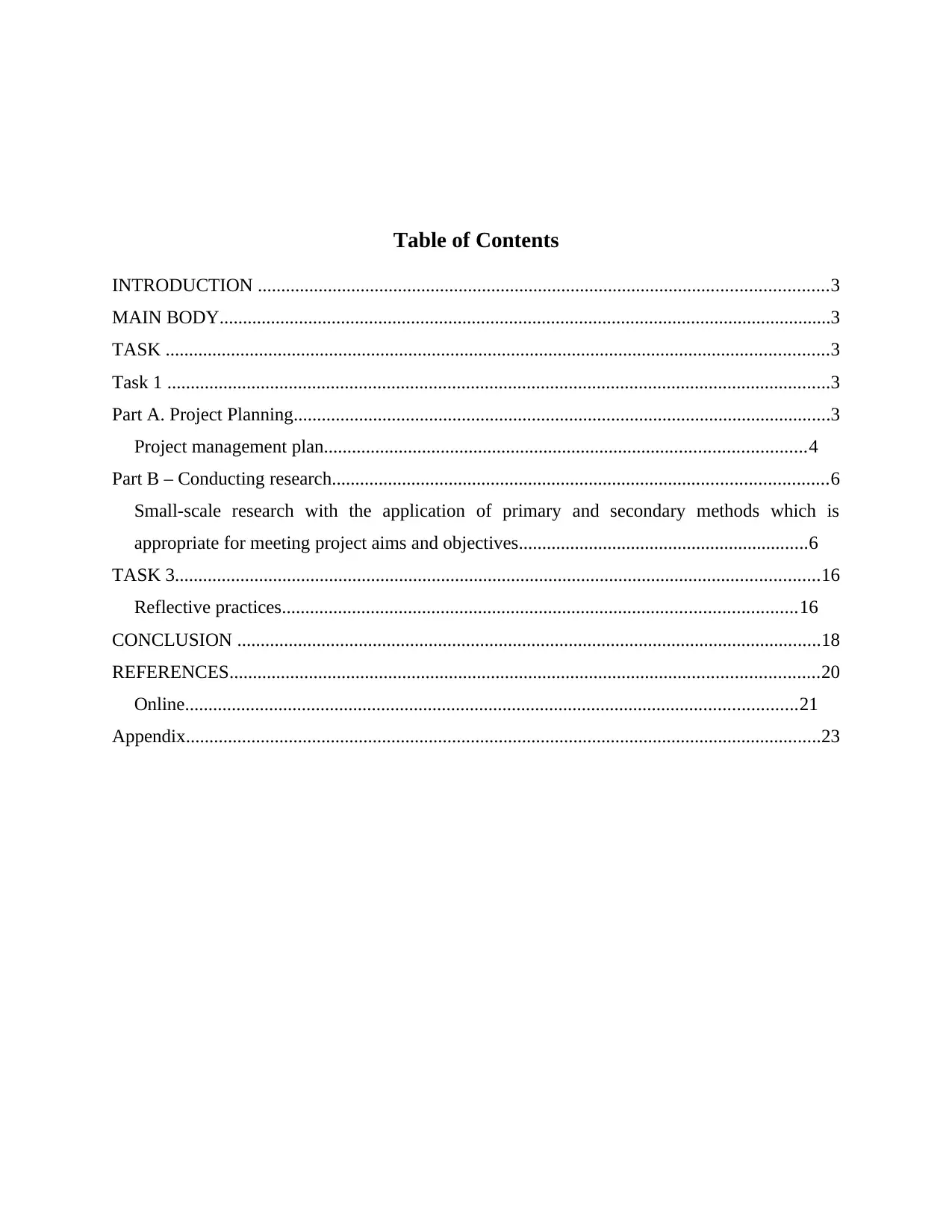
Table of Contents
INTRODUCTION ..........................................................................................................................3
MAIN BODY...................................................................................................................................3
TASK ..............................................................................................................................................3
Task 1 ..............................................................................................................................................3
Part A. Project Planning...................................................................................................................3
Project management plan.......................................................................................................4
Part B – Conducting research..........................................................................................................6
Small-scale research with the application of primary and secondary methods which is
appropriate for meeting project aims and objectives..............................................................6
TASK 3..........................................................................................................................................16
Reflective practices..............................................................................................................16
CONCLUSION .............................................................................................................................18
REFERENCES..............................................................................................................................20
Online...................................................................................................................................21
Appendix........................................................................................................................................23
INTRODUCTION ..........................................................................................................................3
MAIN BODY...................................................................................................................................3
TASK ..............................................................................................................................................3
Task 1 ..............................................................................................................................................3
Part A. Project Planning...................................................................................................................3
Project management plan.......................................................................................................4
Part B – Conducting research..........................................................................................................6
Small-scale research with the application of primary and secondary methods which is
appropriate for meeting project aims and objectives..............................................................6
TASK 3..........................................................................................................................................16
Reflective practices..............................................................................................................16
CONCLUSION .............................................................................................................................18
REFERENCES..............................................................................................................................20
Online...................................................................................................................................21
Appendix........................................................................................................................................23
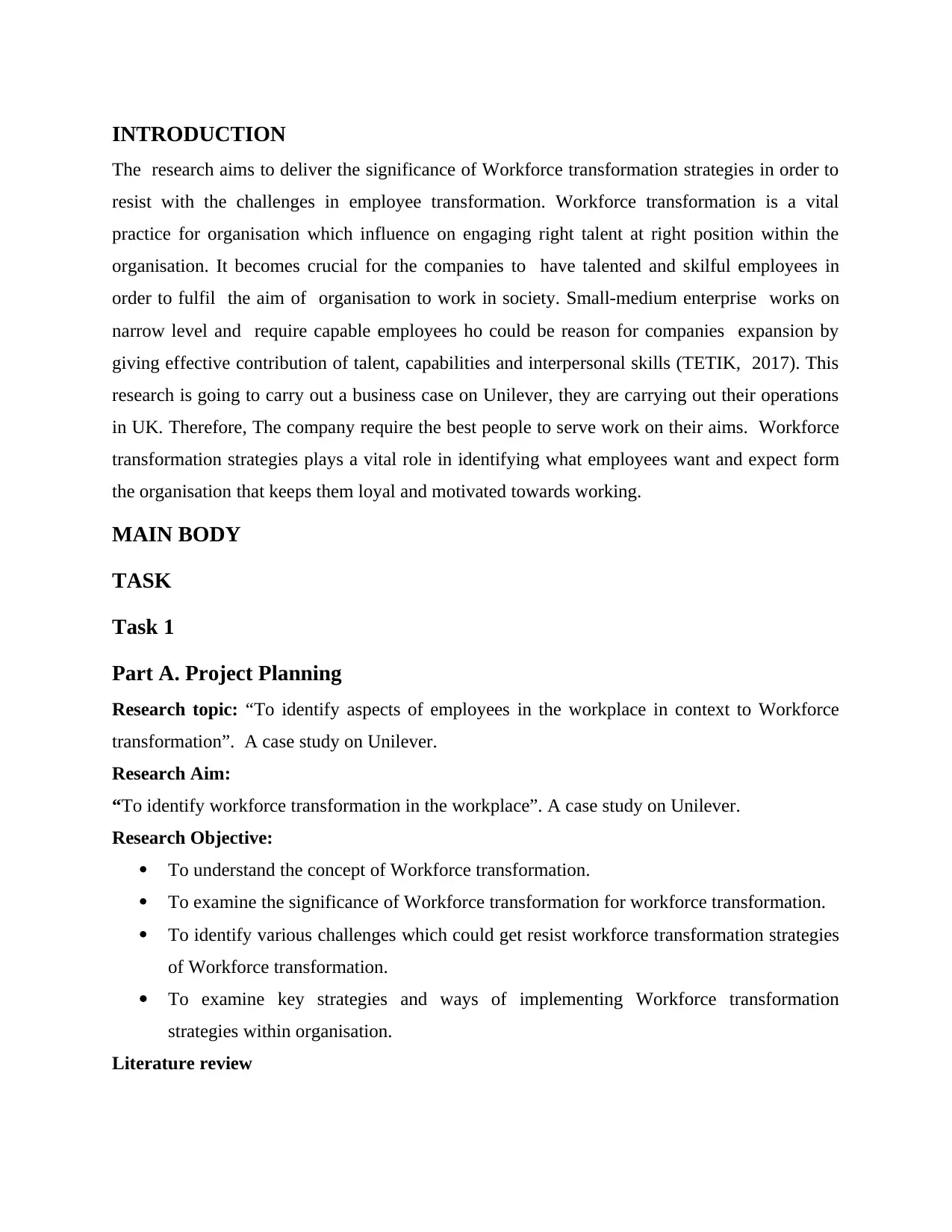
INTRODUCTION
The research aims to deliver the significance of Workforce transformation strategies in order to
resist with the challenges in employee transformation. Workforce transformation is a vital
practice for organisation which influence on engaging right talent at right position within the
organisation. It becomes crucial for the companies to have talented and skilful employees in
order to fulfil the aim of organisation to work in society. Small-medium enterprise works on
narrow level and require capable employees ho could be reason for companies expansion by
giving effective contribution of talent, capabilities and interpersonal skills (TETIK, 2017). This
research is going to carry out a business case on Unilever, they are carrying out their operations
in UK. Therefore, The company require the best people to serve work on their aims. Workforce
transformation strategies plays a vital role in identifying what employees want and expect form
the organisation that keeps them loyal and motivated towards working.
MAIN BODY
TASK
Task 1
Part A. Project Planning
Research topic: “To identify aspects of employees in the workplace in context to Workforce
transformation”. A case study on Unilever.
Research Aim:
“To identify workforce transformation in the workplace”. A case study on Unilever.
Research Objective:
To understand the concept of Workforce transformation.
To examine the significance of Workforce transformation for workforce transformation.
To identify various challenges which could get resist workforce transformation strategies
of Workforce transformation.
To examine key strategies and ways of implementing Workforce transformation
strategies within organisation.
Literature review
The research aims to deliver the significance of Workforce transformation strategies in order to
resist with the challenges in employee transformation. Workforce transformation is a vital
practice for organisation which influence on engaging right talent at right position within the
organisation. It becomes crucial for the companies to have talented and skilful employees in
order to fulfil the aim of organisation to work in society. Small-medium enterprise works on
narrow level and require capable employees ho could be reason for companies expansion by
giving effective contribution of talent, capabilities and interpersonal skills (TETIK, 2017). This
research is going to carry out a business case on Unilever, they are carrying out their operations
in UK. Therefore, The company require the best people to serve work on their aims. Workforce
transformation strategies plays a vital role in identifying what employees want and expect form
the organisation that keeps them loyal and motivated towards working.
MAIN BODY
TASK
Task 1
Part A. Project Planning
Research topic: “To identify aspects of employees in the workplace in context to Workforce
transformation”. A case study on Unilever.
Research Aim:
“To identify workforce transformation in the workplace”. A case study on Unilever.
Research Objective:
To understand the concept of Workforce transformation.
To examine the significance of Workforce transformation for workforce transformation.
To identify various challenges which could get resist workforce transformation strategies
of Workforce transformation.
To examine key strategies and ways of implementing Workforce transformation
strategies within organisation.
Literature review
⊘ This is a preview!⊘
Do you want full access?
Subscribe today to unlock all pages.

Trusted by 1+ million students worldwide
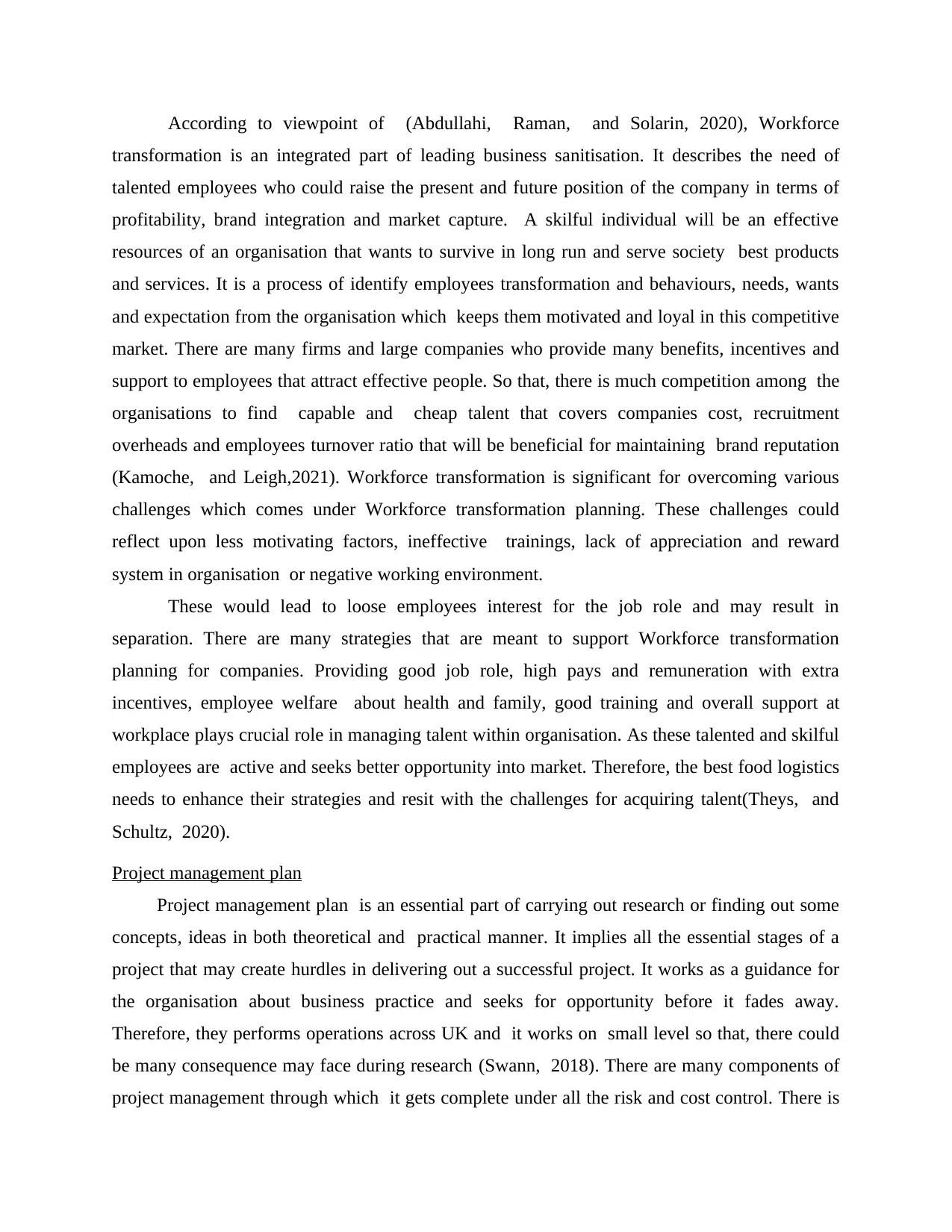
According to viewpoint of (Abdullahi, Raman, and Solarin, 2020), Workforce
transformation is an integrated part of leading business sanitisation. It describes the need of
talented employees who could raise the present and future position of the company in terms of
profitability, brand integration and market capture. A skilful individual will be an effective
resources of an organisation that wants to survive in long run and serve society best products
and services. It is a process of identify employees transformation and behaviours, needs, wants
and expectation from the organisation which keeps them motivated and loyal in this competitive
market. There are many firms and large companies who provide many benefits, incentives and
support to employees that attract effective people. So that, there is much competition among the
organisations to find capable and cheap talent that covers companies cost, recruitment
overheads and employees turnover ratio that will be beneficial for maintaining brand reputation
(Kamoche, and Leigh,2021). Workforce transformation is significant for overcoming various
challenges which comes under Workforce transformation planning. These challenges could
reflect upon less motivating factors, ineffective trainings, lack of appreciation and reward
system in organisation or negative working environment.
These would lead to loose employees interest for the job role and may result in
separation. There are many strategies that are meant to support Workforce transformation
planning for companies. Providing good job role, high pays and remuneration with extra
incentives, employee welfare about health and family, good training and overall support at
workplace plays crucial role in managing talent within organisation. As these talented and skilful
employees are active and seeks better opportunity into market. Therefore, the best food logistics
needs to enhance their strategies and resit with the challenges for acquiring talent(Theys, and
Schultz, 2020).
Project management plan
Project management plan is an essential part of carrying out research or finding out some
concepts, ideas in both theoretical and practical manner. It implies all the essential stages of a
project that may create hurdles in delivering out a successful project. It works as a guidance for
the organisation about business practice and seeks for opportunity before it fades away.
Therefore, they performs operations across UK and it works on small level so that, there could
be many consequence may face during research (Swann, 2018). There are many components of
project management through which it gets complete under all the risk and cost control. There is
transformation is an integrated part of leading business sanitisation. It describes the need of
talented employees who could raise the present and future position of the company in terms of
profitability, brand integration and market capture. A skilful individual will be an effective
resources of an organisation that wants to survive in long run and serve society best products
and services. It is a process of identify employees transformation and behaviours, needs, wants
and expectation from the organisation which keeps them motivated and loyal in this competitive
market. There are many firms and large companies who provide many benefits, incentives and
support to employees that attract effective people. So that, there is much competition among the
organisations to find capable and cheap talent that covers companies cost, recruitment
overheads and employees turnover ratio that will be beneficial for maintaining brand reputation
(Kamoche, and Leigh,2021). Workforce transformation is significant for overcoming various
challenges which comes under Workforce transformation planning. These challenges could
reflect upon less motivating factors, ineffective trainings, lack of appreciation and reward
system in organisation or negative working environment.
These would lead to loose employees interest for the job role and may result in
separation. There are many strategies that are meant to support Workforce transformation
planning for companies. Providing good job role, high pays and remuneration with extra
incentives, employee welfare about health and family, good training and overall support at
workplace plays crucial role in managing talent within organisation. As these talented and skilful
employees are active and seeks better opportunity into market. Therefore, the best food logistics
needs to enhance their strategies and resit with the challenges for acquiring talent(Theys, and
Schultz, 2020).
Project management plan
Project management plan is an essential part of carrying out research or finding out some
concepts, ideas in both theoretical and practical manner. It implies all the essential stages of a
project that may create hurdles in delivering out a successful project. It works as a guidance for
the organisation about business practice and seeks for opportunity before it fades away.
Therefore, they performs operations across UK and it works on small level so that, there could
be many consequence may face during research (Swann, 2018). There are many components of
project management through which it gets complete under all the risk and cost control. There is
Paraphrase This Document
Need a fresh take? Get an instant paraphrase of this document with our AI Paraphraser
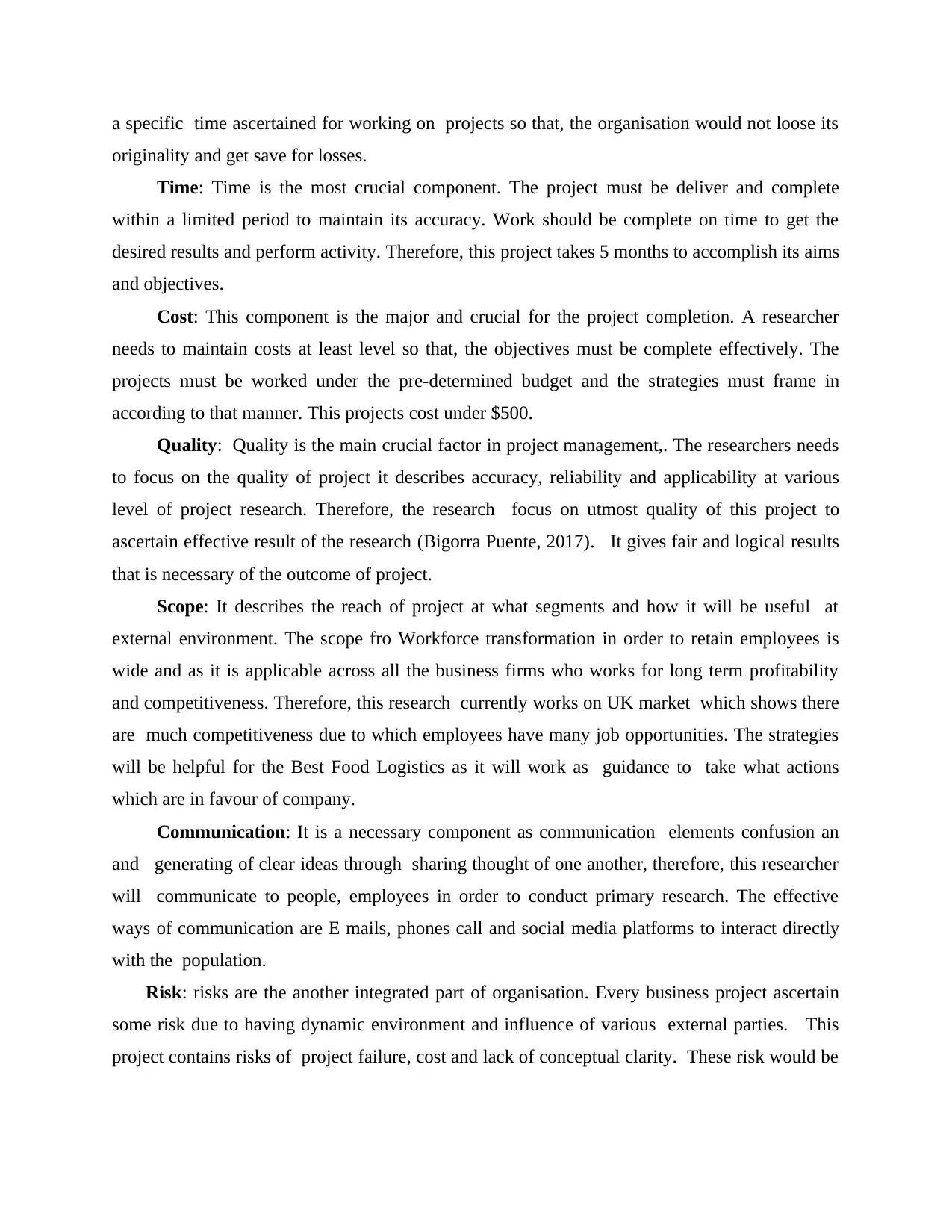
a specific time ascertained for working on projects so that, the organisation would not loose its
originality and get save for losses.
Time: Time is the most crucial component. The project must be deliver and complete
within a limited period to maintain its accuracy. Work should be complete on time to get the
desired results and perform activity. Therefore, this project takes 5 months to accomplish its aims
and objectives.
Cost: This component is the major and crucial for the project completion. A researcher
needs to maintain costs at least level so that, the objectives must be complete effectively. The
projects must be worked under the pre-determined budget and the strategies must frame in
according to that manner. This projects cost under $500.
Quality: Quality is the main crucial factor in project management,. The researchers needs
to focus on the quality of project it describes accuracy, reliability and applicability at various
level of project research. Therefore, the research focus on utmost quality of this project to
ascertain effective result of the research (Bigorra Puente, 2017). It gives fair and logical results
that is necessary of the outcome of project.
Scope: It describes the reach of project at what segments and how it will be useful at
external environment. The scope fro Workforce transformation in order to retain employees is
wide and as it is applicable across all the business firms who works for long term profitability
and competitiveness. Therefore, this research currently works on UK market which shows there
are much competitiveness due to which employees have many job opportunities. The strategies
will be helpful for the Best Food Logistics as it will work as guidance to take what actions
which are in favour of company.
Communication: It is a necessary component as communication elements confusion an
and generating of clear ideas through sharing thought of one another, therefore, this researcher
will communicate to people, employees in order to conduct primary research. The effective
ways of communication are E mails, phones call and social media platforms to interact directly
with the population.
Risk: risks are the another integrated part of organisation. Every business project ascertain
some risk due to having dynamic environment and influence of various external parties. This
project contains risks of project failure, cost and lack of conceptual clarity. These risk would be
originality and get save for losses.
Time: Time is the most crucial component. The project must be deliver and complete
within a limited period to maintain its accuracy. Work should be complete on time to get the
desired results and perform activity. Therefore, this project takes 5 months to accomplish its aims
and objectives.
Cost: This component is the major and crucial for the project completion. A researcher
needs to maintain costs at least level so that, the objectives must be complete effectively. The
projects must be worked under the pre-determined budget and the strategies must frame in
according to that manner. This projects cost under $500.
Quality: Quality is the main crucial factor in project management,. The researchers needs
to focus on the quality of project it describes accuracy, reliability and applicability at various
level of project research. Therefore, the research focus on utmost quality of this project to
ascertain effective result of the research (Bigorra Puente, 2017). It gives fair and logical results
that is necessary of the outcome of project.
Scope: It describes the reach of project at what segments and how it will be useful at
external environment. The scope fro Workforce transformation in order to retain employees is
wide and as it is applicable across all the business firms who works for long term profitability
and competitiveness. Therefore, this research currently works on UK market which shows there
are much competitiveness due to which employees have many job opportunities. The strategies
will be helpful for the Best Food Logistics as it will work as guidance to take what actions
which are in favour of company.
Communication: It is a necessary component as communication elements confusion an
and generating of clear ideas through sharing thought of one another, therefore, this researcher
will communicate to people, employees in order to conduct primary research. The effective
ways of communication are E mails, phones call and social media platforms to interact directly
with the population.
Risk: risks are the another integrated part of organisation. Every business project ascertain
some risk due to having dynamic environment and influence of various external parties. This
project contains risks of project failure, cost and lack of conceptual clarity. These risk would be
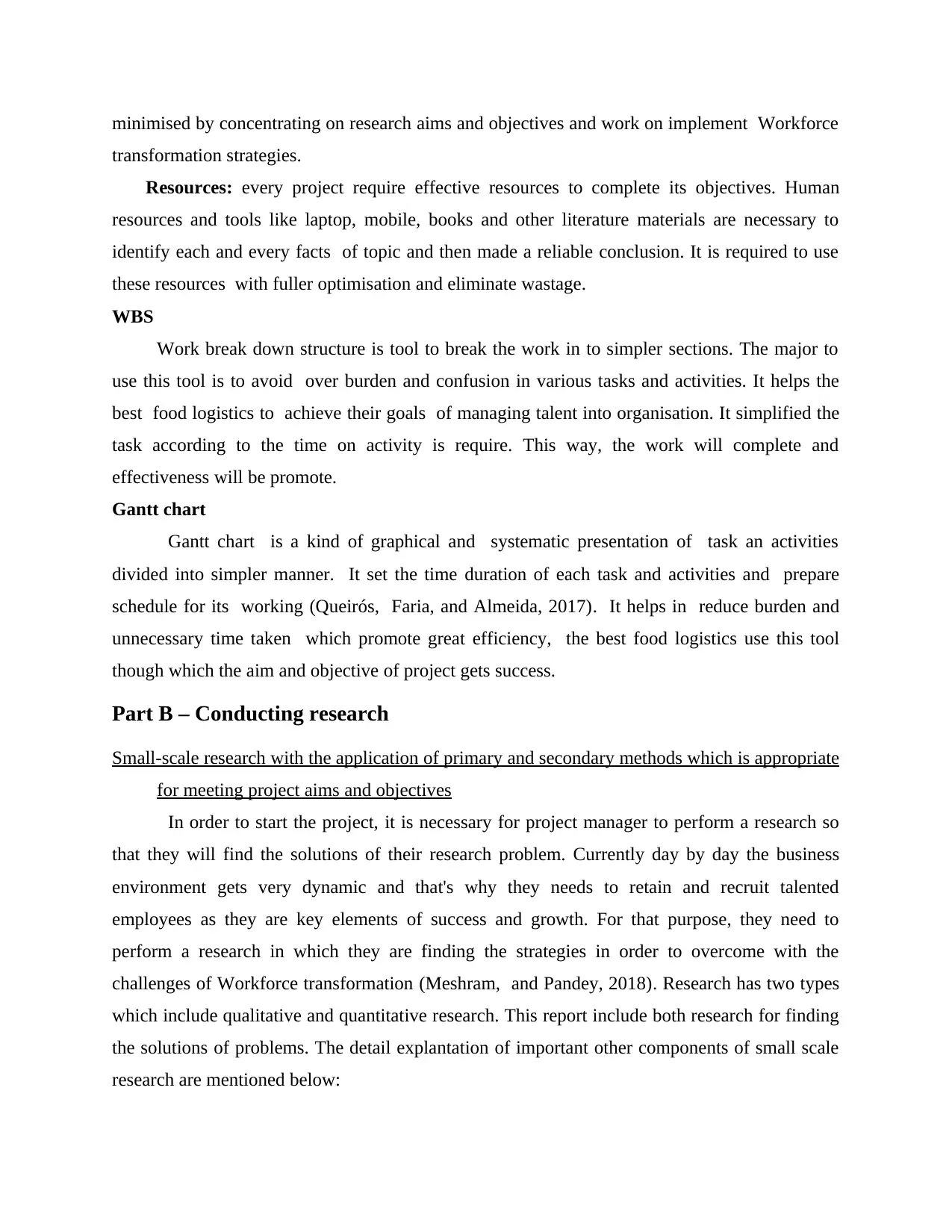
minimised by concentrating on research aims and objectives and work on implement Workforce
transformation strategies.
Resources: every project require effective resources to complete its objectives. Human
resources and tools like laptop, mobile, books and other literature materials are necessary to
identify each and every facts of topic and then made a reliable conclusion. It is required to use
these resources with fuller optimisation and eliminate wastage.
WBS
Work break down structure is tool to break the work in to simpler sections. The major to
use this tool is to avoid over burden and confusion in various tasks and activities. It helps the
best food logistics to achieve their goals of managing talent into organisation. It simplified the
task according to the time on activity is require. This way, the work will complete and
effectiveness will be promote.
Gantt chart
Gantt chart is a kind of graphical and systematic presentation of task an activities
divided into simpler manner. It set the time duration of each task and activities and prepare
schedule for its working (Queirós, Faria, and Almeida, 2017). It helps in reduce burden and
unnecessary time taken which promote great efficiency, the best food logistics use this tool
though which the aim and objective of project gets success.
Part B – Conducting research
Small-scale research with the application of primary and secondary methods which is appropriate
for meeting project aims and objectives
In order to start the project, it is necessary for project manager to perform a research so
that they will find the solutions of their research problem. Currently day by day the business
environment gets very dynamic and that's why they needs to retain and recruit talented
employees as they are key elements of success and growth. For that purpose, they need to
perform a research in which they are finding the strategies in order to overcome with the
challenges of Workforce transformation (Meshram, and Pandey, 2018). Research has two types
which include qualitative and quantitative research. This report include both research for finding
the solutions of problems. The detail explantation of important other components of small scale
research are mentioned below:
transformation strategies.
Resources: every project require effective resources to complete its objectives. Human
resources and tools like laptop, mobile, books and other literature materials are necessary to
identify each and every facts of topic and then made a reliable conclusion. It is required to use
these resources with fuller optimisation and eliminate wastage.
WBS
Work break down structure is tool to break the work in to simpler sections. The major to
use this tool is to avoid over burden and confusion in various tasks and activities. It helps the
best food logistics to achieve their goals of managing talent into organisation. It simplified the
task according to the time on activity is require. This way, the work will complete and
effectiveness will be promote.
Gantt chart
Gantt chart is a kind of graphical and systematic presentation of task an activities
divided into simpler manner. It set the time duration of each task and activities and prepare
schedule for its working (Queirós, Faria, and Almeida, 2017). It helps in reduce burden and
unnecessary time taken which promote great efficiency, the best food logistics use this tool
though which the aim and objective of project gets success.
Part B – Conducting research
Small-scale research with the application of primary and secondary methods which is appropriate
for meeting project aims and objectives
In order to start the project, it is necessary for project manager to perform a research so
that they will find the solutions of their research problem. Currently day by day the business
environment gets very dynamic and that's why they needs to retain and recruit talented
employees as they are key elements of success and growth. For that purpose, they need to
perform a research in which they are finding the strategies in order to overcome with the
challenges of Workforce transformation (Meshram, and Pandey, 2018). Research has two types
which include qualitative and quantitative research. This report include both research for finding
the solutions of problems. The detail explantation of important other components of small scale
research are mentioned below:
⊘ This is a preview!⊘
Do you want full access?
Subscribe today to unlock all pages.

Trusted by 1+ million students worldwide
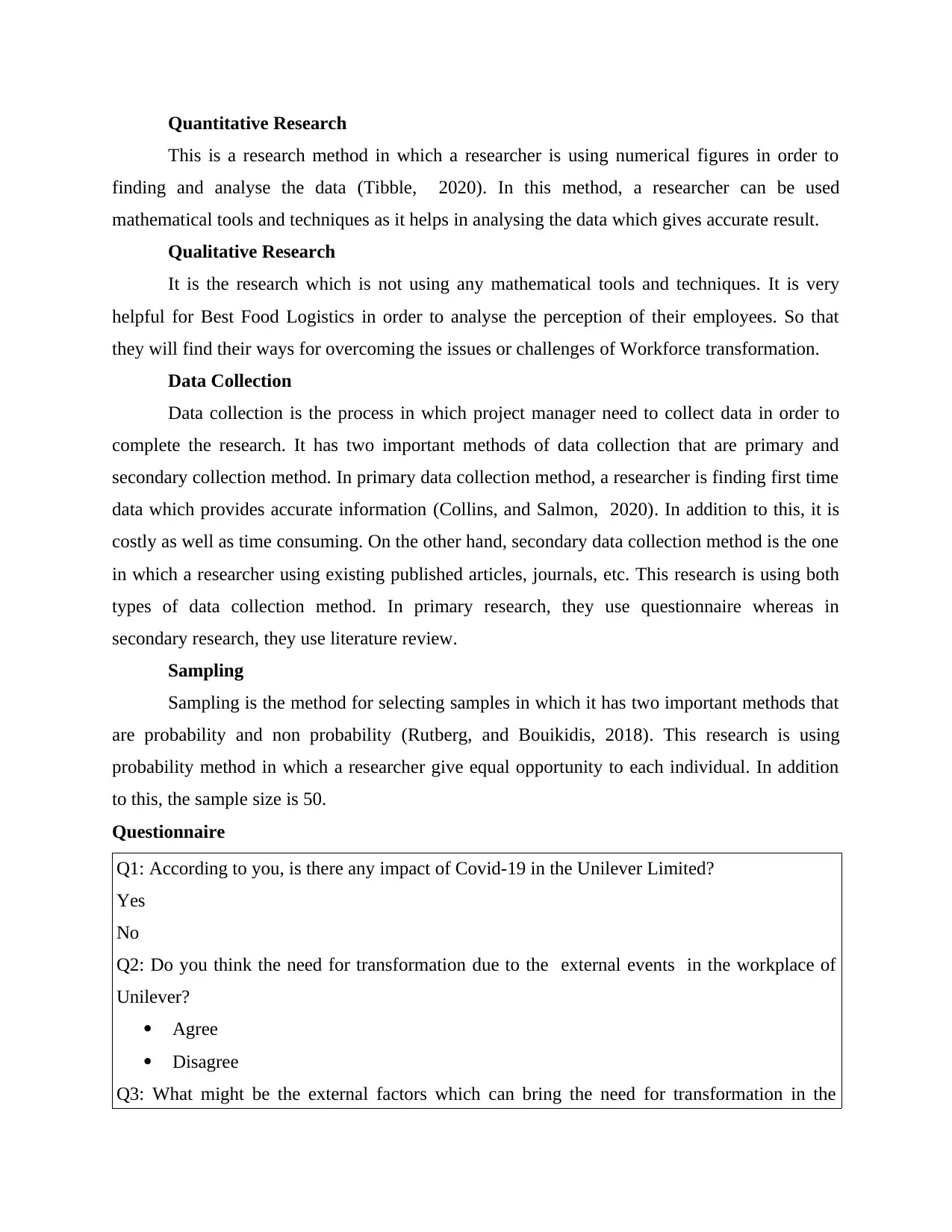
Quantitative Research
This is a research method in which a researcher is using numerical figures in order to
finding and analyse the data (Tibble, 2020). In this method, a researcher can be used
mathematical tools and techniques as it helps in analysing the data which gives accurate result.
Qualitative Research
It is the research which is not using any mathematical tools and techniques. It is very
helpful for Best Food Logistics in order to analyse the perception of their employees. So that
they will find their ways for overcoming the issues or challenges of Workforce transformation.
Data Collection
Data collection is the process in which project manager need to collect data in order to
complete the research. It has two important methods of data collection that are primary and
secondary collection method. In primary data collection method, a researcher is finding first time
data which provides accurate information (Collins, and Salmon, 2020). In addition to this, it is
costly as well as time consuming. On the other hand, secondary data collection method is the one
in which a researcher using existing published articles, journals, etc. This research is using both
types of data collection method. In primary research, they use questionnaire whereas in
secondary research, they use literature review.
Sampling
Sampling is the method for selecting samples in which it has two important methods that
are probability and non probability (Rutberg, and Bouikidis, 2018). This research is using
probability method in which a researcher give equal opportunity to each individual. In addition
to this, the sample size is 50.
Questionnaire
Q1: According to you, is there any impact of Covid-19 in the Unilever Limited?
Yes
No
Q2: Do you think the need for transformation due to the external events in the workplace of
Unilever?
Agree
Disagree
Q3: What might be the external factors which can bring the need for transformation in the
This is a research method in which a researcher is using numerical figures in order to
finding and analyse the data (Tibble, 2020). In this method, a researcher can be used
mathematical tools and techniques as it helps in analysing the data which gives accurate result.
Qualitative Research
It is the research which is not using any mathematical tools and techniques. It is very
helpful for Best Food Logistics in order to analyse the perception of their employees. So that
they will find their ways for overcoming the issues or challenges of Workforce transformation.
Data Collection
Data collection is the process in which project manager need to collect data in order to
complete the research. It has two important methods of data collection that are primary and
secondary collection method. In primary data collection method, a researcher is finding first time
data which provides accurate information (Collins, and Salmon, 2020). In addition to this, it is
costly as well as time consuming. On the other hand, secondary data collection method is the one
in which a researcher using existing published articles, journals, etc. This research is using both
types of data collection method. In primary research, they use questionnaire whereas in
secondary research, they use literature review.
Sampling
Sampling is the method for selecting samples in which it has two important methods that
are probability and non probability (Rutberg, and Bouikidis, 2018). This research is using
probability method in which a researcher give equal opportunity to each individual. In addition
to this, the sample size is 50.
Questionnaire
Q1: According to you, is there any impact of Covid-19 in the Unilever Limited?
Yes
No
Q2: Do you think the need for transformation due to the external events in the workplace of
Unilever?
Agree
Disagree
Q3: What might be the external factors which can bring the need for transformation in the
Paraphrase This Document
Need a fresh take? Get an instant paraphrase of this document with our AI Paraphraser
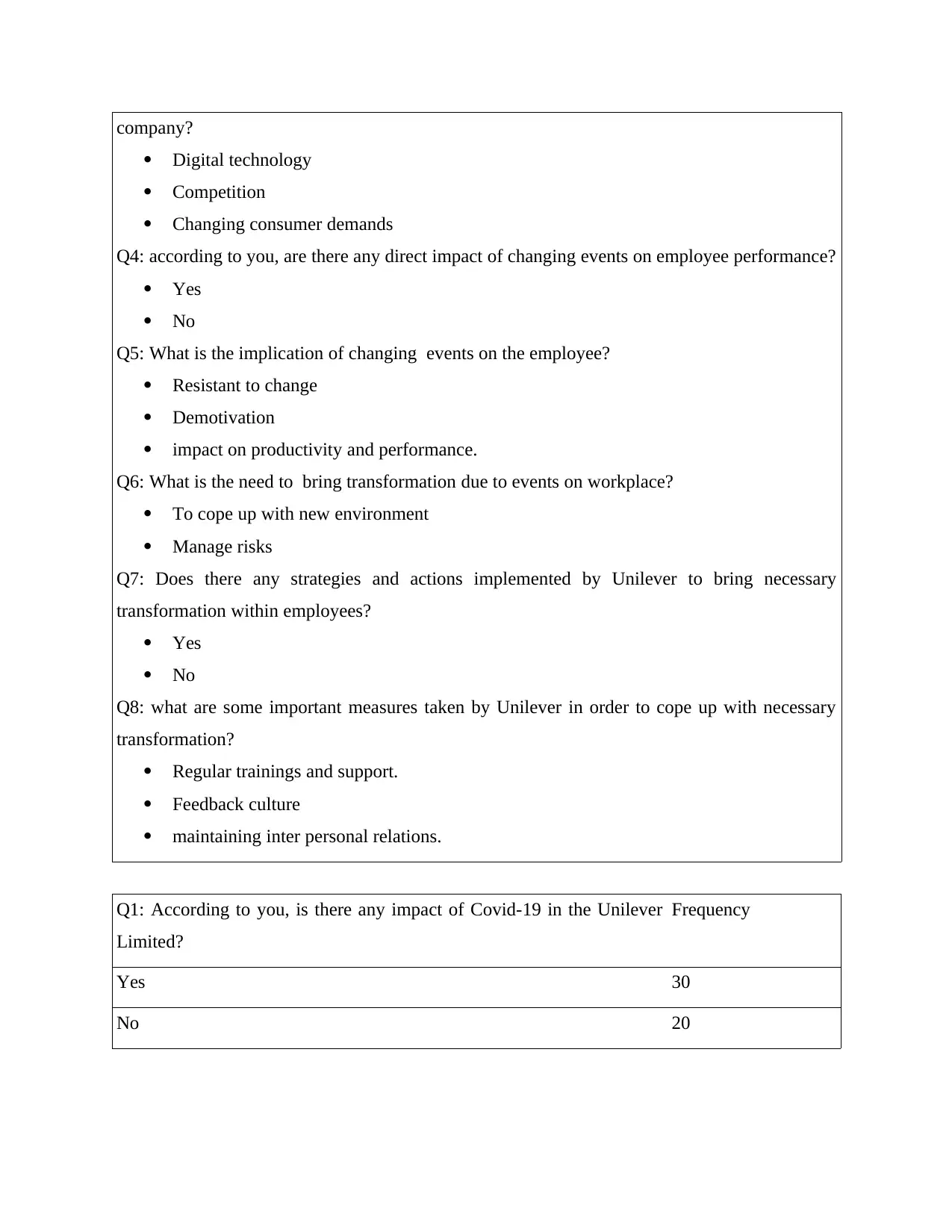
company?
Digital technology
Competition
Changing consumer demands
Q4: according to you, are there any direct impact of changing events on employee performance?
Yes
No
Q5: What is the implication of changing events on the employee?
Resistant to change
Demotivation
impact on productivity and performance.
Q6: What is the need to bring transformation due to events on workplace?
To cope up with new environment
Manage risks
Q7: Does there any strategies and actions implemented by Unilever to bring necessary
transformation within employees?
Yes
No
Q8: what are some important measures taken by Unilever in order to cope up with necessary
transformation?
Regular trainings and support.
Feedback culture
maintaining inter personal relations.
Q1: According to you, is there any impact of Covid-19 in the Unilever
Limited?
Frequency
Yes 30
No 20
Digital technology
Competition
Changing consumer demands
Q4: according to you, are there any direct impact of changing events on employee performance?
Yes
No
Q5: What is the implication of changing events on the employee?
Resistant to change
Demotivation
impact on productivity and performance.
Q6: What is the need to bring transformation due to events on workplace?
To cope up with new environment
Manage risks
Q7: Does there any strategies and actions implemented by Unilever to bring necessary
transformation within employees?
Yes
No
Q8: what are some important measures taken by Unilever in order to cope up with necessary
transformation?
Regular trainings and support.
Feedback culture
maintaining inter personal relations.
Q1: According to you, is there any impact of Covid-19 in the Unilever
Limited?
Frequency
Yes 30
No 20

Interpretation: as per the above graph, it represents that the company is affected with Covid-19
which is agreed by the 30 employees. Whereas, other 20 are disagree as they do not think that the
changes occurred to Covid-19.
Q2: Do you think the need for transformation due to the external events
in the workplace of Unilever?
Frequency
Agree 15
Disagree 35
Yes No
0
5
10
15
20
25
30
30
20
which is agreed by the 30 employees. Whereas, other 20 are disagree as they do not think that the
changes occurred to Covid-19.
Q2: Do you think the need for transformation due to the external events
in the workplace of Unilever?
Frequency
Agree 15
Disagree 35
Yes No
0
5
10
15
20
25
30
30
20
⊘ This is a preview!⊘
Do you want full access?
Subscribe today to unlock all pages.

Trusted by 1+ million students worldwide
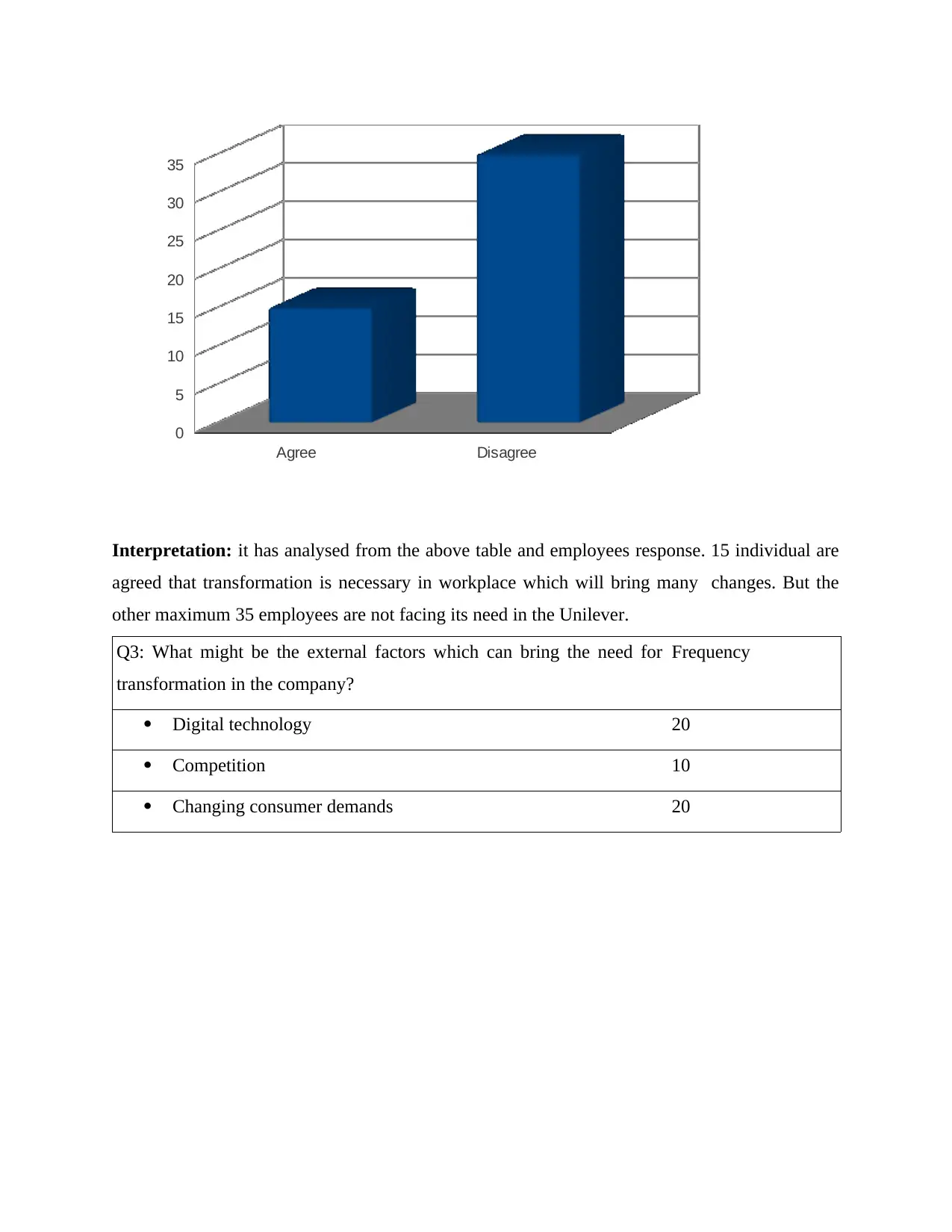
Interpretation: it has analysed from the above table and employees response. 15 individual are
agreed that transformation is necessary in workplace which will bring many changes. But the
other maximum 35 employees are not facing its need in the Unilever.
Q3: What might be the external factors which can bring the need for
transformation in the company?
Frequency
Digital technology 20
Competition 10
Changing consumer demands 20
Agree Disagree
0
5
10
15
20
25
30
35
agreed that transformation is necessary in workplace which will bring many changes. But the
other maximum 35 employees are not facing its need in the Unilever.
Q3: What might be the external factors which can bring the need for
transformation in the company?
Frequency
Digital technology 20
Competition 10
Changing consumer demands 20
Agree Disagree
0
5
10
15
20
25
30
35
Paraphrase This Document
Need a fresh take? Get an instant paraphrase of this document with our AI Paraphraser
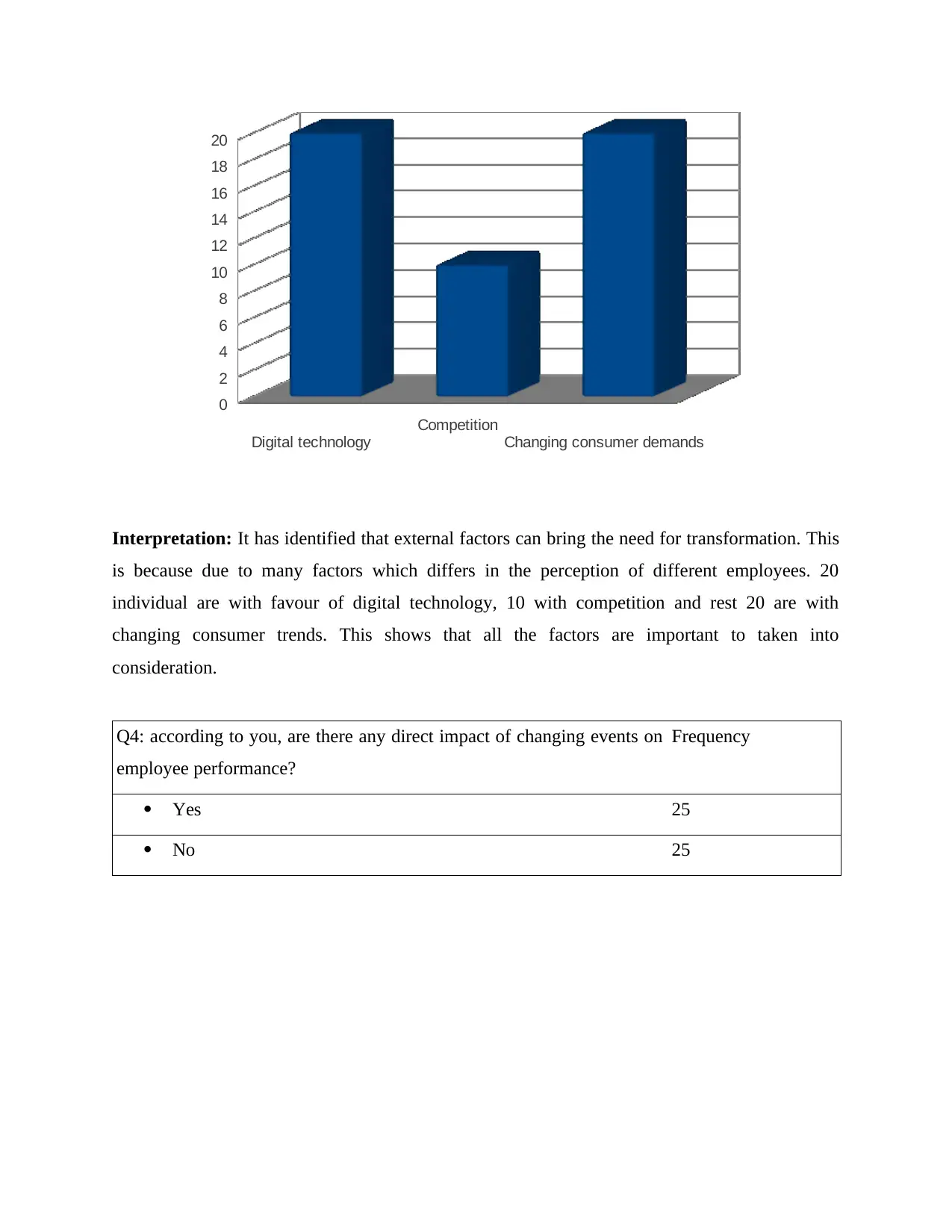
Interpretation: It has identified that external factors can bring the need for transformation. This
is because due to many factors which differs in the perception of different employees. 20
individual are with favour of digital technology, 10 with competition and rest 20 are with
changing consumer trends. This shows that all the factors are important to taken into
consideration.
Q4: according to you, are there any direct impact of changing events on
employee performance?
Frequency
Yes 25
No 25
Digital technology
Competition
Changing consumer demands
0
2
4
6
8
10
12
14
16
18
20
is because due to many factors which differs in the perception of different employees. 20
individual are with favour of digital technology, 10 with competition and rest 20 are with
changing consumer trends. This shows that all the factors are important to taken into
consideration.
Q4: according to you, are there any direct impact of changing events on
employee performance?
Frequency
Yes 25
No 25
Digital technology
Competition
Changing consumer demands
0
2
4
6
8
10
12
14
16
18
20

Interpretation: according to the 25 employees of Unilever, it has shown that there Is direct
impact of changing impact on the employee performance. As these events influence in changing
working practice. Apart from this, rest 25 employees are not seen any direct impact as they are
not the active participants of Unilever.
Q5: What is the implication of changing events on the employee? Frequency
Resistant to change 15
Demotivation 20
impact on productivity and performance. 15
Yes No
0
5
10
15
20
25
Frequency
impact of changing impact on the employee performance. As these events influence in changing
working practice. Apart from this, rest 25 employees are not seen any direct impact as they are
not the active participants of Unilever.
Q5: What is the implication of changing events on the employee? Frequency
Resistant to change 15
Demotivation 20
impact on productivity and performance. 15
Yes No
0
5
10
15
20
25
Frequency
⊘ This is a preview!⊘
Do you want full access?
Subscribe today to unlock all pages.

Trusted by 1+ million students worldwide
1 out of 24
Related Documents
Your All-in-One AI-Powered Toolkit for Academic Success.
+13062052269
info@desklib.com
Available 24*7 on WhatsApp / Email
![[object Object]](/_next/static/media/star-bottom.7253800d.svg)
Unlock your academic potential
Copyright © 2020–2025 A2Z Services. All Rights Reserved. Developed and managed by ZUCOL.




